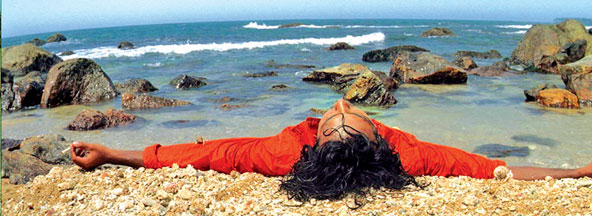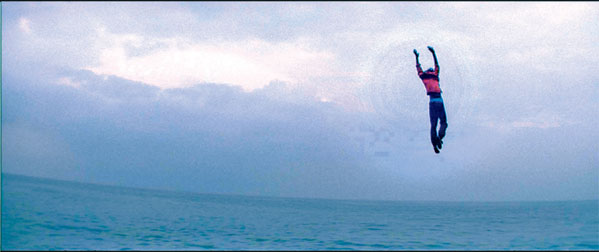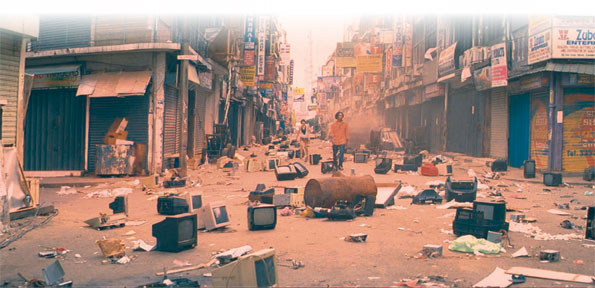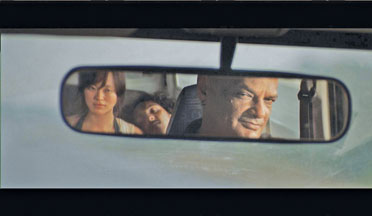|
 Unfulfilled
destinies and blurred realities: Unfulfilled
destinies and blurred realities:
A look at Vimukthi Jayasundera’s ‘Between Two Worlds’.
By Dilshan BOANGE
The long awaited second film of Sri Lanka’s first Cannes Award
winning film maker Vimukthi Jayasundera was screened on a free admission
but first come seating basis at the Goethe Institute (German Cultural
Centre) on 19th February. From what I had heard of it the original title
had been ‘The Fallen’, later I heard it was changed to ‘Fallen from the
sky’. But the title that the screen had as the movie started was
‘Between Two Worlds’. And the choice befitted the work very aptly when
looking at the feeling the story projected.
The screening included Vimukthi’s short film ‘Empty for Love’ which
opened the evening’s screening after the film Director made a quick
intro to the audience which included a cross section of Sri Lankans from
varying professional backgrounds as well as a notable number of expats.
Following the short was the feature, which had as its opening visual a
mountain wrapped in clouds that spoke to me of a resonance with the
impressions of the film Baraka by Ron Fricke and then after the fall, or
drop to the sea of the male figure who is the protagonist, the story
begins.
Unconventionality
An audience attuned to the conventional narrative of linear
storytelling may not relate very well with this story that sans a
concrete beginning of the protagonist’s background, his foundation as a
person and so on. He, played by the young actor Thusitha Laknath
Galindawattha, is exactly what he appears to be at the very outset. A
being dropped on to the earth from above. Lying on the beach bedraggled
and exhausted the young man shows a lethargic sense of reorientation as
he stirs lightly while hermit crabs walk around him, even venturing on
to his arms.
Scaling a vertical rock face he, the fallen being reaches the plane
of human life. But the world that he arrives upon is one that is ripe
with the seeds of chaos now pulsating to burst out in full fury. A
tirade of irrational violence comes on the scene with men breaking shop
windows and smashing TV sets on the ground and setting upon a man
dressed in a Mickey Mouse costume, the kind used in sales promos.
 In
the midst of the violence the young man who fell from the sky escapes in
a van driven by a taciturn driver played by Steve de la Zilva with a
young Chinese woman. After a twisty ride of events that ultimately
leaves the young man in a forested area abandoned with the Chinese woman
and the driver leaving in the van, the narrative cuts to an altogether
different setting changed in time, tone and rhythm. In
the midst of the violence the young man who fell from the sky escapes in
a van driven by a taciturn driver played by Steve de la Zilva with a
young Chinese woman. After a twisty ride of events that ultimately
leaves the young man in a forested area abandoned with the Chinese woman
and the driver leaving in the van, the narrative cuts to an altogether
different setting changed in time, tone and rhythm.
The prophetic storytellers
A conversation of two fishermen begins. One played by the late great
Joe Abeywickrama this dialogue which is captured in a still wide angle
frame brings in an element that works as a baseline to guide the viewer
through the film, of the sequence that is set to unfold. The two
fishermen are of two generations but bond as comrades having no barrier
between them talking freely as peers taking swigs of a bottle shared
between them.
What is most interesting in this captivating dialogue is that the
concept of storytelling has been brought into a modern sense of
adaptability where the focus, the objective is to keep the story going
and evolving as necessary to make it fresh to make it engaging and not
outdated and stale. This I believe is what rendered Vimukthi’s film an
evolution in the concept of storytelling and hints at what the implied
deal is between the filmmaker and the audience.
There is always room for sharing, room for contributions, a space for
participation in storytelling since no single person is the owner of any
story that has been narrated over and over again, becoming something
more than its original form every time it is told, and retold.
The two fishermen are like prophets who in their detachedness from
the world in chaos, in their splendid isolation, sketch out the
rationale to understand the story that unfold in visual sequences
somewhat abstractly.
The story they tell is one that had been told and retold but is told
once more but with input from the younger one to mould it to be more
suitable to their taste and engagement.
 Through
the segment of the two fishermen Vimukthi sets out the politics of
storytelling and weaves a subtle threading of questioning the authority
of a story. It is after all the act of the storyteller that can make him
also a ‘story maker’. Through
the segment of the two fishermen Vimukthi sets out the politics of
storytelling and weaves a subtle threading of questioning the authority
of a story. It is after all the act of the storyteller that can make him
also a ‘story maker’.
Building on history
The story the two fishermen ‘discuss’ and construct between them is a
plot that runs with marked similarity to the historic episode of Prince
Pandukhabaya. While they make their own twists to the story their
dialogue ends with the younger of the two saying that the prince is as
he believes still hiding in the hollow of the tree he took refuge in to
escape his assassins.
The camera cuts to a frame of a tree on which is a visible small
hollow. The camera cuts again to the visual of the inside of a bus where
the protagonist sits shirtless, dozing off. It is at this point that the
connection is created between the story of the fishermen and the two
subsequent visuals.
The fallen being embodies the new age myth –the prophesied ‘prince’
the fishermen were talking about.
He gets off the bus onto a winding road in a mountainous region as
the fishermen said, since they rebutted the notion of such a person
being brought up secretly in their own coastal locales but in a safe
hilly region, safe from the plots of the murderous uncles who seek
relentlessly to kill him.
The story that follows seems disjointed with the nameless protagonist
traversing the forest being intimidated by an unseen speaker who
threatens him to run away as fast as possible.
Reactions of a mediatised society
This element of inexplicability in terms of ‘realism’ appeared as a
symbolic reflection of the omnipresent ‘Big brother’ in an Orwellian
sense. The upsurge in the people at the beginning seemed like a possible
breakdown of the system that is built on today’s intense mediatisation.
 The
trashing of TV sets in this sense can be a rejection by the people of
the intense media control prevalent in society which inadvertently may
also be a rejection of the controllers of (the) mass media. The
trashing of TV sets in this sense can be a rejection by the people of
the intense media control prevalent in society which inadvertently may
also be a rejection of the controllers of (the) mass media.
In the idyllic setting the protagonist is set in, there seems to be a
blurring of reality from the world that he escaped.
The cut off from all signs of urbanism posits him in a new journey of
findings. He finds a woman played by Kaushalya Fernando whose
relationship to him is ambiguous to say the least.
One may conjecture that this is the mother. The mother to whom he has
returned with his oedipal feelings and fulfils a union of both mind and
body with her though it blurs from the surreal to the material. One may
suggest that this is an old acquaintance and not his biological mother
but nevertheless maternal figure who proffers to him her maternal
affection.
A filial, maternal symbiosis
Vimukthi in building this symbiosis between the two figures weaves a
set of symbols to build the imagery that creates a guessing game to the
viewer.
The nurturing quality associated with the image of breastfeeding is
taken to a new level of idea building when in one scene a human breast
is milked (shown in a tight close shot) and the milk collected on to a
spoon.
As the camera tracks we see that this is done in a dark indoors where
a candle’s light is all that allows illumination. The spoon moves over
the face of the protagonist who is lying belly up.
The contents held by the spoon is gently dripped onto his open eye.
This is quite a potently built to coalesce some very potent symbolism
which connotes dynamics of human bonds as linked to the human body and
its politics.
Perhaps the milk of a lactating mother is meant to wash his eyes
clean of all the sins it has seen and see the world anew, as a newborn?
The conjectures are many and surely not limited to a single explanative
interpretation. Kaushalya’s character with whom the protagonist has very
intimate physical interactions, and at one instance holds out in her
palm milk she gets from milking her breast (which is not shown to the
camera) which the protagonist questions surprised and doubtful almost,
asking her how it’s possible since she isn’t a lactating mother. The
reply from the woman is that love alone can produce human milk.
The dawn of deaths
The land where the story unfolds has no young men in the open as they
are all believed to be hiding in a single tree hollow for fear of being
killed by assassins sent by the two ruling kings (uncles of the prince
according to the two fishermen’s story).
 The
protagonist is told of this and taken to the tree by a small boy in the
village he comes upon. But later the protagonist learns that the young
men have all come out and find them emptying a small lake like body of
water, which may even be the very same one that the villagers came to
learn had been poisoned. The
protagonist is told of this and taken to the tree by a small boy in the
village he comes upon. But later the protagonist learns that the young
men have all come out and find them emptying a small lake like body of
water, which may even be the very same one that the villagers came to
learn had been poisoned.
And in a scene that seemed to be somewhat overdone in its theatrics
the young men in their united efforts succeed in emptying out the tank
only to be butchered by horse riding assassins towards dawn.
The film ends with a zooming in visual of the tree hollow in which
the protagonist is hiding safely, having found refuge and saved himself
from death. Thus the last line in the dialogue of the fishermen is
proven true, that the prince is probably still hiding in the tree hollow
and not yet fulfilled his destiny of overthrowing the tyrannical rulers.
The story ends on a note that speaks of an unfulfilled destiny if the
dialogue of the fishermen is to be taken as a sort of guide to the layer
of conceptualism the story stands on.
The story of Prince Pandhukhabaya being remoulded in the manner
fitting a new age futuristic scenario, or possibly an alternative future
scenario makes Vimukthi’s film truly postmodern in the light of taking
freedoms to create a scenario of writing a future as if though rewriting
an episode of history.In this film one does not find any element of
historicising but a disregard of the authority of historians since the
two fishermen take it upon themselves to retell a well told story and in
the process of it to remould it to their liking.
Irrespective of whether or not ‘Between two worlds’ feels like an
experiment for an abstract film it has truly worked on laudable elements
of projecting postmodernism on to the screen of Sri Lankan cinema. The
audience becomes a participant in telling the story, giving the story a
multiplicity of meanings in the sanctum of his inner thoughts with just
as much right as the filmmaker. |

